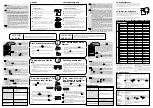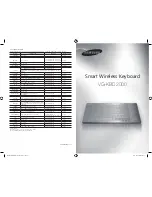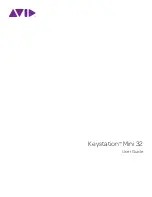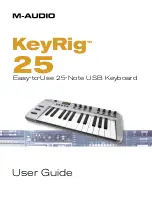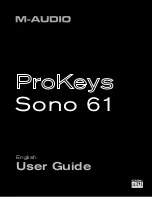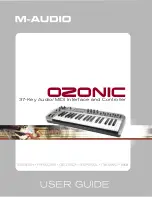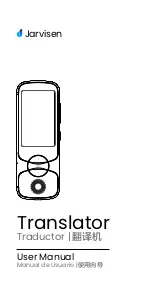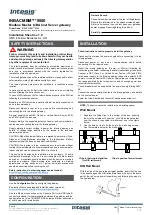
Let’s listen
and play!
Inside the PSS-7, there are 10 songs. First, let’s listen to the first song in the
SONGS list, “Mickey Mouse March”, and then try playing along with it.
Start “Mickey Mouse March”.
Press the blue SONGS
button one time.
You know this song very well. It’s “Mickey Mouse
March”.
Press the red
button, and “Mickey Mouse March”
will stop.
Next, let’s try to play along with the song.
Try playing along with the
song.
If you are ready, try playing along with the song on
the keyboard. The melody disappears and you can hear
the notes you play.
Try playing the melody to “Mickey Mouse March”
karaoke style.
How did you do? If it was too hard to play, try play-
ing it at a slower tempo (the song’s speed).
“One, two, three, four!”. Try
starting the song like this.
Press the red
button to stop the song.
Tap the
button four times like this. “One, two,
three, four”.
Did the song play at the speed you tapped?
Is this an easier tempo to play along with? You can
also use the tempo
buttons to adjust the tempo.
If you think it’s a little too fast, press the
button.
You will hear a “PON”, and the tempo will slow down a
little.
If you think it’s a little too slow, press the
button.
You will hear a “PON”, and the tempo will speed up
a little.
Drücke einmal auf die blaue SONGS
-Taste.
Du kennst diesen Song bestimmt. Es ist der Micky-
Maus-Marsch.
Drücke die rote
-Taste, um den Micky-Maus-Marsch
wieder zu stoppen.
Als nächstes versuchen wir, zum Song dazuzuspielen.
Wenn Du möchtest, kannst Du die Noten auch selbst
auf der Tastatur spielen. Die Melodie verschwindet, und
Du kannst die Noten hören, die Du auf der Tastatur
spielst.
Versuche einmal, die Melodie des Micky-Maus-Marsch
selbst zu spielen.
Wie war es? Wenn es zu schwer ist, kannst Du den
Song auch langsamer machen.
Drücke die rote
-Taste, um den Song zu stoppen.
Drücke nun viermal so schnell auf die
-Taste, wie
der Song spielen soll: “Eins, zwei, drei und los”.
Wird der Song nun in diesem Tempo gespielt?
Kannst Du die Melodie jetzt besser dazuspielen? Du
kannst den Song auch mit den TEMPO-Tasten
und
schneller oder langsamer machen.
Wenn das Tempo zu schnell ist, drückst Du auf die
-Taste. Du hörst dabei ein “PONG”, und das Tempo
wird ein bißchen langsamer.
Wenn das Tempo zu langsam ist, drückst Du auf die
-Taste. Du hörst dabei ein “PONG”, und das Tempo
wird ein bißchen schneller.
Den “Mickey Mouse March”
starten.
Hören und
spielen wir!
When you press the blue
SONGS
button, the first song
in the song list, “Mickey Mouse
March” will start. The next time you press it, the
second song “Little Brown Jug”, starts, and so on.
After the tenth song in the list, “Over the Rainbow”,
the next song to be selected will be the first song in
the list “Mickey Mouse March”.
• To start playback from the beginning of the se-
lected song, press the red
button to stop play-
back, then press the
button to start play-
back of the song from the beginning.
Beim ersten Druck auf die
blaue SONGS
-Taste wird
der erste Song in der Liste gespielt,
der “Mickey Mouse March”. Beim nächsten
Tastendruck spielt der nächste Song, “Little Brown
Jug”, und so fort. Wenn auf diese Weise bis zum
zehnten Song, “Over the Rainbow”, weiter-
geschaltet wurde, spielt beim nächsten Tastendruck
wieder der “Mickey Mouse March”.
• Wenn der Song noch einmal von Anfang an
gespielt werden soll, zunächst die Wiedergabe
mit der roten
-Taste stoppen, und dann die
-Taste drücken, um den Song noch einmal
zu spielen.
1
2
3
• Wenn einen Takt lang keine Taste angeschlagen wird, setzt das
Melodiespiel des PSS-7 wieder ein.
• Beim Auswählen eines Songs mit der
-Taste gibt das PSS-7
automatisch ein passendes Instrument für Tastaturspiel vor.
• Bei Songs in 3/4-Takt muß die
-Taste 3mal gedrückt werden.
• Die
-Taste kann zum Einstellen des Tempos auch gedrückt wer-
den, während der Song spielt.
• Wenn die
-Taste in zu langen Abständen gedrückt wird, ändert
sich das Tempo nicht. Wird die
-Taste in zu kurzen Abständen
gedrückt, spielt der Song im schnellsten Tempo von 240 Viertel pro
Minuten.
• Das Tempo kann im Bereich von
q
q
q
q
q
=40-240 eingestellt werden.
• Wenn beim Drücken der Taste
oder
kein “PONG” zu hören
ist, war bereits das schnellste oder langsamste Tempo eingestellt.
• Wenn man die Tasten
und
gleichzeitig drückt, wird das an-
fängliche Tempo wieder eingestellt.
• If the song is in 3/4 time, tap the
button 3 times.
• If you tap the
button while the song is playing, the song’s tempo
will adjust to the same speed that you tapped.
• If you tap the
button too slowly, the tap function will not oper-
ate. If you tap the
button too fast, the tempo will be set to 240
beats per minute.
One, two,
three, four.
When the STAND BY—ON
switch is turned ON you hear
a “buzz” sound.
●
Trouble Shooting
Problem
Solution
• The sound is distorted when
the keyboard is played, and
suddenly the fanfare plays.
• Playback of Song or Perfor-
mance is distorted, the play-
back suddenly stops and the
fanfare plays.
There is no sound when you
play on the keyboard.
If a key on the keyboard is held down at
the same time you are pressing a but-
ton the button may not operate properly.
Zum Song dazuspielen.
“Eins, zwei, drei, vier!”.
Den Song noch einmal im
eigenen Tempo starten.
Das PSS-7 kann 10 Lieder oder Songs spielen. Hören wir uns zuerst einmal
das erste Lied in der SONGS-Liste an, den “Mickey Mouse March”. Versuche
auch, auf der Tastatur dazuzuspielen.
This is a result of electricity flowing
through the instrument. It is not a
problem at all.
Battery power is low. Replace all four
batteries with a new set of batteries.
You are playing three or more keys at
one time. You can only play a maximum
of two keys at one time.
The panel buttons do not
function properly.
●
Using Headphones
When you want to practice quietly by yourself or, play at night,
connect a pair of headphones to the headphone jack located on the rear
panel. When headphones are connected the sound from the internal
speaker will automatically be switched off.
If you use headphones, do not play at a loud volume so as to dam-
age your hearing.
●
Instrument List / Instrumentenverzeichnis
• Using AC Power
Using the PA-3B optional AC adaptor.
1
Connect the AC adaptor’s DC plug to the DC Inlet Jack
located on the rear panel.
2
Connect the AC Plug to any convenient AC wall socket.
* The AC adaptor is not a toy.
• Using Batteries
1
Turn the PSS-7 upside-down, and remove the battery com-
partment cover.
2
Insert four 1.5V “AA” size (R6P or SUM-3) or equivalent
manganese or alkaline batteries. Make sure the batteries
are inserted in the same manner as shown in the illustra-
tion.
3
Replace the battery compartment cover.
Your PSS-7 will run either from batteries or an optional AC
adaptor.
Das PSS-7 kann über einen Netzadapter (Sonderzubehör) mit
Netzstrom oder mit Batterien betrieben werden.
• Betrieb mit Netzadapter
Gebrauch des Netzadapters PA-3B (Sonderzubehör).
1
Zunächst den kleinen Stecker am Kabelende an die Buchse
“DC IN 10-12V” an der Rückwand anschließen.
2
Den Netzstecker dann in eine Steckdose stecken.
* Der Netzadapter ist kein Spielzeug!
• Betrieb mit Batterien
1
Das PSS-7 umdrehen und den Batteriefachdeckel entfernen.
2
Vier R6P-Batterien (SUM-3 Größe “AA”, 1.5 V) oder
gleichwertige Mangan- bzw. Alkalibatterien einlegen. Dar-
auf achten, daß die Batterien mit den in der Abbildung ge-
zeigten Polausrichtungen einlegt werden.
3
Den Batteriefachdeckel wieder anbringen.
●
Technische Daten
Wenn “im stillen” geübt werden soll, können Kopfhörer an die
HEADPHONES/AUZ OUT-Buchse an der Rückwand angeschlossen
werden. Beim Beschalten dieser Buchse wird der Lautsprecher des In-
struments automatisch vom Signalweg getrennt.
Beim Gebrauch von Kopfhörern darauf achten, daß die Lautstärke
nicht zu hoch eingestellt wird, um Hörschäden zu vermeiden.
B e i m E i n s c h a l t e n m i t d e m
STAND BY—ON-Schalter ist ein
“Summton” zu hören.
●
Fehlersuche
Problem
Abhilf e
• Der Ton klingt beim Spielen auf
der Tastatur verzerrt, und die
Fanfare ist plötzlich zu hören.
• Die Wiedergabe eines Songs
o d e r B a n d - S t ü ck s k l i n g t
verzerrt, oder die Wiedergabe
setzt plötzlich ganz aus, und
die Fanfare ist zu hören.
Kein Ton beim Spielen auf der
Tastatur.
Wenn beim Betätigen einer Bedienfeld-Ta-
ste eine Taste an der Tastatur gedrückt ge-
halten wird, funktionier t die betätigte
Bedienfeld-Taste unter Umständen nicht.
Dies wird durch den in das Instrument flie-
ßenden Strom verursacht und ist kein
Grund zur Besorgnis.
Die Batterien sind verbraucht. Alle vier Bat-
terien durch frische ersetzen.
Es wurden mehr als zwei Tasten gleichzei-
tig angeschlagen. Das Instrument kann je-
weils nur zwei gleichzeitige Tastenan-
schläge verarbeiten.
Die Tasten am Bedienfeld funktio-
nieren nicht ordnungsgemäß.
NUR einen Yamaha Netzadapter PA-3B (oder einen anderen von
Yamaha ausdrücklich empfohlenen Netzadapter) für den Netz-
betrieb verwenden. Bei Gebrauch eines anderen Netzadapters kann
der Adapter selbst sowie auch das PSS-7 irreparabel beschädigt
werden.
Wir empfehlen, verbrauchte Batterien so bald wie möglich durch
frische zu ersetzen. Wenn die Batterien schwächer werden, nimmt
die Lautstärke ab, wobei auch die Tonqualität leidet. In diesem Fall
die Batterien unter Beachtung der folgenden Punkte auswechseln.
• Beim Einlegen der Batterien bitte unbedingt die
Polmarkierungen (“+” und “–”) im Batteriefach beachten.
Falsch eingelegte Batterien können sich überhitzen, einen
Brand verursachen und auslaufen.
• Stets ALLE Batterien durch frische ersetzen. Niemals
gebrauchte und neue Batterien gemeinsam einlegen. Bitte
auch keine Batterien unterschiedlichen Typs mischen (Alkali-
und Manganbatterien, Batterien verschiedener Hersteller oder
unterschiedliche Batterien desselben Herstellers). Dies kann
eine Überhitzung, einen Brand und ein Auslaufen der
Batterien zur Folge haben.
• Um Schäden durch auslaufende Batterien zu vermeiden und
Batteriestrom zu sparen, sollten die Batterien aus dem In-
strument genommen werden, wenn dieses voraussichtlich
längere Zeit nicht gebraucht wird.
• Auch wenn Batterien eingelegt sind, schaltet das Instrument
automatisch auf Netzstromversorgung um, wenn es über den
Netzadapter an eine Steckdose angeschlossen wird.
Use ONLY a Yamaha PA-3B AC Power Adaptor (or other adaptor
specifically recommended by Yamaha) to power your instrument
from the AC mains. The use of other adaptors may result in irrepa-
rable damage to both the adaptor and the PSS-7.
It is highly recommended that you change worn batteries as soon
as possible. As battery power weakens, the volume will decrease
and sound quality will also degrade. When this occurs pay atten-
tion to the following cautions and change the batteries.
• Be sure to follow the b/– polarity indications on the
case when inserting the batteries. Improper installation of
batteries may result in overheating, fire, and battery leakage.
• Replace ALL batteries at the same time. Never mix new and
old batteries. Also, don’t mix battery types (alkaline and man-
ganese, different makers, or different types by the same maker).
Mixing batteries may result in overheating, fire, and battery
leakage.
• To prevent possible damage due to battery leakage, and to
save battery power, remove the batteries if the instrument is
not to be used for a long time.
• Even if batteries are installed, the keyboard will automatically switch
to AC power when the AC adaptor is connected to AC current.
●
Power
●
Stromversorgung
NORMAL
EFFECT (
x 1)
PHRASE (
x 2)
FUNNY (
x 3)
PIANO
SUSTAIN
RAGTIME
GAME OVER
(
x 1)
PIANO
PIANO
E GUITAR
ECHO
CHOKING
UNLUCKY
(
x 2)
GUITAR
GUITAR
SAXOPHONE
TENOR SAX
SAX SOLO
TAP DANCE
(
x 3)
E BASS
SYNTH BASS
BASS SOLO
SYNTH BASS
(
x 4)
PHRASE
PERCUSSION
8 BEAT
DRUM SOLO
COMIC DRUM
(
x 5)
E PIANO
ECHO
E PIANO
PUNCH LINE
(
x 1)
E PIANO
PHRASE
HARPSICHORD
SUSTAIN
BAROQUE
MUSIC BOX
(
x 2)
HARPSICHORD
PHRASE
ORGAN
ECHO ORGAN
WEDDING
FUGA
(
x 3)
CLAVI
SUSTAIN
CLAVI
CHINA
(
x 4)
CLAVI
PHRASE
ACCORDION
ECHO
ACCORDION
BOUNCE
(
x 5)
ACCORDION
PHRASE
F GUITAR
TREMOLO
GUITAR
GUITAR
(
x 6)
GUITAR
ARPEGGIO
PHRASE
VIOLIN
ECHO
VIOLIN
COMPUTER
(
x 7)
VIOLIN
PHRASE
STRINGS
ECHO
STRINGS
FANTASIA
(
x 8)
STRINGS
PHRASE
HARP
SUSTAIN
HARP
HARP
(
x 9)
HARP
ARPEGGIO
ARPEGGIO 2
BANJO
ECHO
COUNTRY
TAISHO
(
x 10)
BANJO
PHRASE
-KOTO
TRUMPET
ECHO
TRUMPET
FANFARE
(
x 1)
TRUMPET
PHRASE
FLUTE
CLARINET
FLUTE
AMBULANCE
(
x 2)
PHRASE
HARMONICA
ECHO
HARMONICA
THE END
(
x 3)
HARMONICA
PHRASE
VIBRAPHONE
TREMOLO
VIB
RIGHT
(
x 4)
VIB
PHRASE
ANSWER
MARIMBA
TREMOLO
MARIMBA
BELL
(
x 5)
MARIMBA
PHRASE
PIG
DOG
PIG’S
DOG’S
(
x 6)
SONG
SONG
CAT
COW
CAT’S
COW’S
(
x 7)
SONG
SONG
TELEPHONE
LINE IS
TIME
POLICE
(
x 8)
BUSY
SIGNAL
CAR
TV GAME
TV GAME 2
PICOPICO
WRONG
(
x 9)
ANSWER
CHORUS
ECHO
SYMPHONY
BACK
(
x 10)
CHORUS
NO.9
CHORUS
COMBO
KEYBO
ARD
STRING
WIND+
EFFECTS
VARIA TION
Beim Einschalten des PSS-7 wird automatisch das
erste Instrument von
(PIANO) gewählt. Wenn man
danach ein anderes Instrument der
-Liste wählen
möchte, muß man die Taste einmal weniger drücken als
angegeben.
When the PSS-7 is switched “ON”, the first instru-
ment in the
list (PIANO) will be selected. To slect
another voice from the
list just after the PSS-7 is
switched “ON”, subtract 1 from the times required to
select a voice.
Wenn der gewünschte Klang gefunden ist, die Ta-
ste
,
oder
so oft drücken, wie in der Liste
angegeben, und danach im Falle eines Variations-
instruments die Taste
so oft drücken, wie für das
Instrument angegeben ist.
When you find the sound you want to play, first
press the
~
button the number of times shown in
the list, and then if necessary press the
button the
number of times shown in the list.
○○○○○○○○○○○○○○○○○○○○○○○○○○○○○○○
○○○○○○○○○○○○○○○○○○○○○○○○○○○○○○○○○○○○○○○○○○○○○○○○○○○○○○○○○○○○○○○○○○○○○○○○○○○○○○○○○○○○○○○○○○○○○○○○○○○○○○○○○○○○○○○○○○
• If the keyboard is not played for one measure, the PSS-7 will play
the melody again.
• When you press the
button to select a song, the PSS-7 will
automatically select an instrument that matches the song for you
to play on the keyboard.
●
Gebrauch von Kopfhörern
• The tempo can be adjusted between
q
q
q
q
q
=40-240.
• If you press the
or
button and you don’t hear a “PON”, the
tempo is at its highest or lowest setting and cannot be set any faster
or slower.
• Simultaneously press the
,
buttons to return the tempo to its
original setting.
Eins, zwei,
drei, vier!
●
Specifications
Keyboar ds
Number of Keys: 32, Key Size: Ultra-mini, Register: F2~C5
Voice (Instrument)
AWM 100 voices
Song
10 (KARAOKE)
Band
30
Contr ol
STAND BY — ON Switch, INSTRUMENTS (
~
) Button, Variatrion
(
)Button, SONGS
Button, BANDS (
~
) Button, Stop
Button, TEMPO
Button, Tap
Button, VOLUME
But-
ton
Amplifier s
0.5 W (when using batteries)
Speaker
6.6cm (2”-3/8) x1, 8
Ω
Rated Volta ge
DC 6 V
: 4 “AA” size/R6P/SUM-3 (1.5 V) batteries
DC 10-12V : PA-3B AC power adaptor
Dimensions
332 x 193 x 49 mm (13”-1/16 x 7”-5/8 x 1”-15/16)
Weight
0.5kg (1 lbs. 2 oz)
Tastatur
Anzahl Tasten: 32, Tastengröße: Mini, Umfang: F2~C5
Stimmen (Instrumente) 100 AWM-Stimmen
Songs
10 (KARAOKE)
Bands
30
Bedienelemente
STAND BY — ON-Schalter, INSTRUMENTS-Schalter (
~
), VARIA-
TION-Schalter (
), SONGS-Schalter
, BANDS-Schalter
(
~
) , Stop-Schalter
, TEMPO-Schalter
, Taktvorgabe-
Schalter
, VOLUME-Schalter
Verstärker
0,5 W (bei Batteriebetrieb)
Lautsprec her
6,6 cm x 1, 8
Ω
Betriebsspann
ung
6 V Gleichstrom
: 4 R6P-Batteriezellen (Größe “AA”, SUM-3, 1,5 V)
10-12 V Gleichstrom : Netzadapter PA-3B
Abmessung en
332 x 193 x 49 mm
Gewic ht
0,5 kg
* To remove the batteries, follow the procedure above, tak-
ing out the four batteries in step 2.
* Zum Entfernen der Batterien den obigen Vorgang aus-
führen und die vier Batterien in Schritt 2 aus dem Instru-
ment nehmen.


